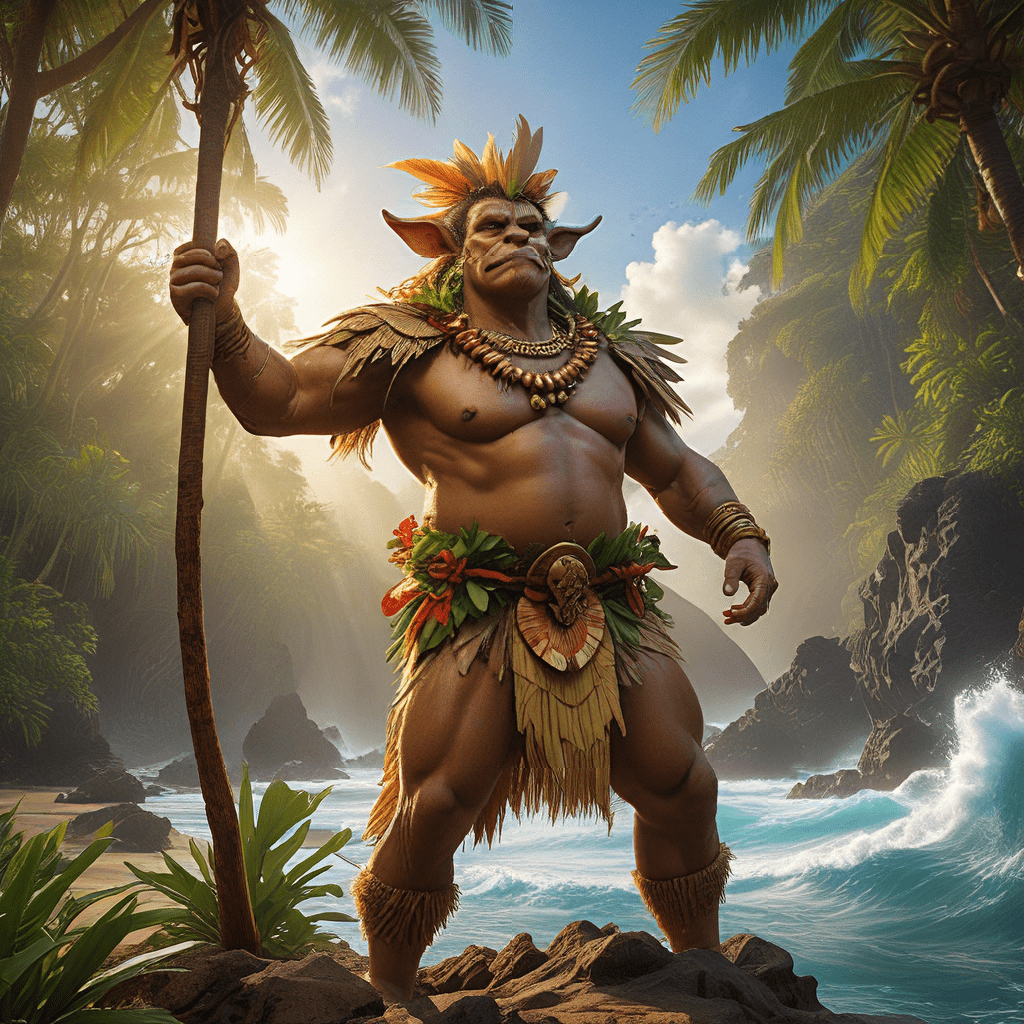The Concept of Kapu: A Foundation of Hawaiian Society
In the rich tapestry of Hawaiian culture, the concept of kapu stands as a fundamental pillar, shaping every aspect of life from daily routines to religious practices. The word "kapu" translates to "forbidden" or "sacred," encompassing a complex system of rules and regulations that governed the behavior of Hawaiians for centuries. This intricate system of laws, believed to be divinely ordained, served as the foundation of Hawaiian society, establishing order, maintaining balance, and protecting the sacredness of their world.
Kapu encompassed a vast array of restrictions, encompassing everything from food choices and social interactions to the use of land and the worship of deities. It was a multi-layered system that dictated what could be eaten, what rituals could be performed, who could enter certain areas, and even who could speak to whom. The system was designed to maintain a harmonious relationship between the human world and the spiritual realm.
The Origins of Kapu: Divine Laws and Cosmic Order
According to Hawaiian mythology, kapu originated with the gods, who established these rules to ensure the well-being of both humanity and the natural world. The gods were believed to possess immense power, known as mana, which permeated all things. Kapu was a means of respecting this mana and maintaining a balance within the cosmic order.
The most important kapu were believed to be handed down directly from the gods, while others evolved over time through tradition and the decisions of the chiefs. These rules were seen as sacred and inviolable, reflecting the belief that transgressing kapu could lead to disastrous consequences, including natural disasters, illness, and even death.
Kapu as a System of Social Control
Beyond its religious significance, kapu functioned as a powerful tool for social control. By defining the roles and responsibilities of different social classes, kapu solidified the existing hierarchy and ensured the smooth functioning of Hawaiian society. For example, the aliʻi (chiefs) were granted significant privileges, while commoners were subject to strict limitations, reflecting their place in the social order.
The kapu system also served to regulate resource allocation, particularly when it came to fishing and farming. Restrictions on certain fishing grounds or specific types of food ensured that important resources were preserved and that no single group monopolized them.
The Role of the Aliʻi in Enforcing Kapu
The aliʻi, as the representatives of the gods on Earth, were responsible for upholding and enforcing the kapu system. They had the authority to impose new kapu and to adjudicate disputes related to violations. The aliʻi often relied on a network of priests and chiefs to assist in enforcing kapu, using a combination of persuasion, punishment, and public shaming to deter transgressions.
As custodians of the kapu, the aliʻi played a critical role in maintaining order and ensuring the stability of Hawaiian society. Their authority was deeply intertwined with the belief that they had a divine mandate to uphold the sacred laws of the gods.
The Consequences of Breaking Kapu: Punishment and Taboo
Violating kapu was a serious offense, carrying significant consequences both in this life and the next. The severity of punishment varied depending on the nature of the transgression and the status of the offender. In some cases, the penalty might be as simple as a fine or a public reprimand, while in others it could involve exile, imprisonment, or even death.
The fear of supernatural retribution also loomed large. Hawaiian beliefs held that breaking kapu could incur the wrath of the gods, leading to illness, misfortune, or even natural disasters. This fear of the divine served as a powerful deterrent, reinforcing the importance of kapu in the lives of Hawaiians.
The Diverse Scope of Kapu: Food, Gender, and Religion
The kapu system touched every aspect of Hawaiian life, dictating rules for everything from what could be eaten to how people interacted with each other. Some kapu were universally observed, while others varied based on location, social status, or specific circumstances. The vast range of kapu reflects the deep importance of order and balance in Hawaiian culture.
One of the most prominent categories of kapu revolved around food. Certain foods, like certain fish or fruits, were reserved for the aliʻi and were forbidden to commoners. These restrictions served a practical purpose, ensuring that resources like rare fish were not depleted and that the aliʻi had access to essential sustenance. But they also held symbolic meaning, reflecting the aliʻi's special relationship with the gods and their role as intermediaries between the divine and the human world.
Gender played a significant role in the kapu system. Men and women were often subject to different rules, reflecting the traditional division of labor and the importance of maintaining separate spheres of influence. For instance, women were prohibited from entering certain sacred areas or engaging in certain activities, while men were restricted from engaging in activities associated with women's roles. These restrictions were thought to protect the integrity of each gender and maintain harmony within the community.
Religion was inextricably linked to kapu. Temples, priests, and rituals were all subject to specific regulations. For example, only certain individuals were allowed to enter temples, and specific rituals were required to appease the gods. Violating these kapu could invite the wrath of the deities and bring misfortune upon the entire community.
Kapu and the Sacred Land: Restrictions on Natural Resources
The kapu system extended to the natural world, recognizing the sacredness of the land and the need to respect its resources. Certain areas were designated as kapu (sacred) and were forbidden to anyone except those with special permission. This included areas like forests, mountains, and fishing grounds that were considered to be inhabited by deities or spirits.
Restrictions on fishing were also common, limiting the types of fish that could be caught or the methods that could be used. These kapu were designed to ensure that fish stocks were not depleted and to prevent the disruption of the natural balance. They also reflected a deep reverence for the creatures of the sea and their role in the ecosystem.
Land was a precious resource in Hawaii, and the kapu system ensured that it was used responsibly and sustainably. Certain areas were designated for specific purposes, like farming or fishing, and regulations were in place to prevent overgrazing or overharvesting. The kapu system helped to maintain the health of the ecosystem and ensured that future generations could enjoy the benefits of the land.
The Role of Mana in Defining Kapu
The concept of mana was central to the understanding of kapu. Mana is a supernatural force that permeates all things, both living and inanimate. Objects, places, and people can possess mana in varying degrees, making them powerful or sacred. Kapu served as a way to respect and protect the mana that resided in the natural world and in certain individuals.
For example, a sacred grove or a tomb might be considered kapu because of the high concentration of mana present in these locations. Similarly, the aliʻi were believed to possess greater mana than commoners, which is why they were subject to special rules and privileges.
Kapu was a way to acknowledge and protect the mana that flowed through the universe and to maintain a harmonious relationship between the human world and the spiritual realm.
Theories on the Origin and Purpose of Kapu
The origins of the kapu system are shrouded in mystery, but scholars have proposed various explanations for its development and purpose. One prominent theory suggests that kapu arose as a way to regulate access to resources, particularly in times of scarcity. This view sees kapu as a pragmatic solution to the challenges of resource management, particularly in a land with limited resources.
Another theory emphasizes the role of religion in the development of kapu. This perspective suggests that kapu were divinely ordained rules that served to maintain order and protect the sacredness of the world. The gods were believed to have established kapu to ensure the well-being of humanity and the natural world, and breaking these rules could invite the wrath of the deities.
A third perspective focuses on the social and political functions of kapu. This view argues that kapu played a significant role in maintaining the social hierarchy and cementing the power of the aliʻi. By creating a system of rules that differentiated the aliʻi from commoners, kapu helped to legitimize the aliʻi's authority and to ensure their position of power.
The Evolution of Kapu: Changes Over Time and the Fall of the System
The kapu system was not static but evolved over time, reflecting the changing needs of Hawaiian society. New kapu were introduced, while others were abolished or modified. Some changes were driven by the desire to maintain order or to address new challenges, while others were the result of shifts in religious beliefs or political power.
The kapu system began to decline in the 18th century, as contact with Europeans brought new ideas and challenges to Hawaii. The introduction of Christianity and the Western concept of law led to a gradual erosion of the kapu system. The aliʻi also began to question the legitimacy of the kapu system, particularly as they were exposed to new ways of thinking and governance.
In 1819, King Kamehameha II abolished the kapu system in a public ceremony, marking a significant turning point in Hawaiian history. The abolition of kapu paved the way for modernization and westernization, but it also marked the loss of a vital part of Hawaiian cultural heritage.
FAQ:
Q: What is the main purpose of kapu in Hawaiian mythology?
A: The main purpose of kapu was to maintain order and balance in the universe, ensuring the well-being of both humans and the natural world. It was believed to be a divinely ordained system that reflected the will of the gods and the importance of respecting the sacredness of all things.
Q: What are some examples of kapu rules?
A: Kapu rules included restrictions on food, gender roles, access to sacred areas, and the use of natural resources. For example, some foods were forbidden to commoners, women were prohibited from entering certain areas, and specific rituals were required when approaching deities.
Q: How was kapu enforced?
A: Kapu was enforced by the aliʻi (chiefs), who had a divine mandate to uphold the sacred laws. They relied on priests, chiefs, and others to help them enforce kapu. Punishments for breaking kapu ranged from fines to exile to death.
Q: What was the significance of the abolition of kapu in 1819?
A: The abolition of kapu marked a significant turning point in Hawaiian history, signifying the end of a traditional system of governance and the beginning of a new era of Western influence and modernization.
Q: Why is kapu still relevant today?
A: Kapu remains relevant today as a testament to the importance of respect, balance, and the interconnectedness of all things. It serves as a reminder of the importance of preserving cultural heritage and of acknowledging the sacredness of the natural world.




